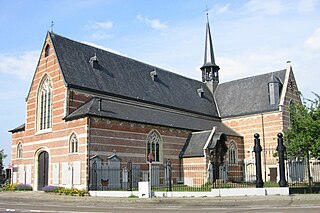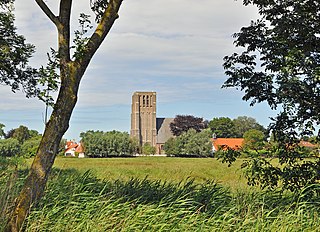Some will have it, that he journeyed to Rome ; yet, although such pilgrimages to the shrines of the Apostles and martyrs there were undertaken by the Irish, Scots and Angles, soon after their conversion to Christianity, there does not appear to have been sufficient warrant for that statement in reference to St. Guthagon. Through religious motives, however, he entered on a pilgrimage, and with a companion, named Gillon. They arrived in Belgium, but at what period is not with certainty known. They rested at a place known as Knocken or Cnokem, which was situated on the maritime shore of Flanders. Nor was it far removed from Oostkerke. This village lay near Burges, on the sea side, between it and Slusa. There the virtuous life of St. Guthegon gave very great edification to the people of that country. Another companion, Gildulfus, is commemorated with the foregoing, and he spent an eremitical life with them, in Belgium. Here, St. Guthagon led a solitary life, until the time of his death. It is not known for certain, whether he died at Cnokem or at Oostkerke. However, the clergy and people of that district reverently interred his body, according to tradition in the western part of the cemetery of Oostkerke. Those holy men, Saints Guthagon and Gillon, rest at Oist-Kerke, in Flanders.
After St. Guthagon's death, miracles were wrought at his grave. Gerald, Bishop of Tourney, in the year 1159 exhumed St. Guthagon's body and placed It in a feretrum. The Abbots of Aldenburg, Dunens and of Quercetan were presents. It would seem, that at a subsequent period, towards the end of A.D. 1444. there was another translation of St. Guthagon's remains. In the succeeding century, Jean Ver-Meulen relates, that he saw these relics kept within iron gratings in the wall of the church. It has been remarked in our saint's office, that the shrine was hardly kept in a becoming manner. The Calvinists profaned the relics of St. Guthagon after the Reformation, and they seem to have utterly destroyed them; nothing having remained but a tooth of the holy man, which had been transferred to the collegiate church of St. Saviour, at Bruges. On the case containing.it had been inscribed these words : "Dens S. Guthagonis."
In the beginning of the last century, the tooth of St. Guthagon was kept in the church at Oostkerke, and on the 3rd day of each July, it was there exposed for the veneration of the faithful. Formerly, his feast was kept there with great solemnity, and on it there was an obligation for hearing Mass. This, however, had been abrogated, yet a proper office for a Confessor not a Pontiff had been recited, and he was invoked as a minor patron of that place. The feast of this saint is set down at the 3rd of July, in the enlarged edition of Usuard's Martyrology; also, in a Manuscript Catalogue of the Saints &Scotland ; as likewise, in the Breviary of Aberdeen. John Wilson, in his " Martyrologium Anglicanum," sets him down as an Irishman, at this day. The name of Gutbagon occurs, at this date, in the anonymous Catalogue, published by O'Sullevan Beare, as Guthagonius. Molanus and Henry Fitz-Simon set him down, as Guthagonus, Rex et Confessor, at the 3rd July.," Again, a feast has been assigned to him, at the 1st of October. This appears as having reference to the Translation of his Relics.





